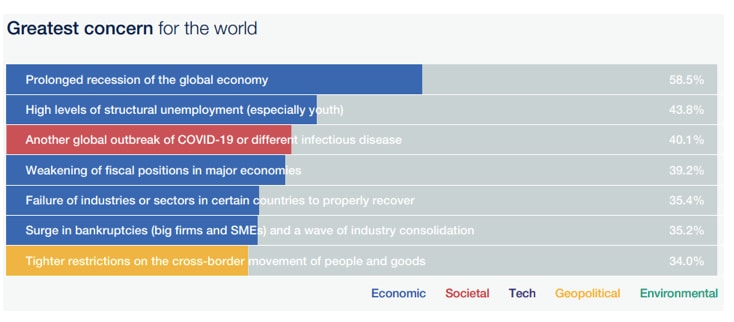How digital identity can improve lives in a post-COVID-19 world

Digital identity lets people assert who they are without revealing more than the strictly necessary information.
Image: Unsplash
Stay up to date:
Digital Identity
- Industries from travel to health to education will recover more quickly if solutions once primarily associated with the finance sector are harnessed effectively.
- Building trust with citizens around the secure usage of personal data will be key to creating effective frameworks.
- Policymakers need to move as quickly as the technology.
The World Travel and Tourism Council predicted in November 2020 that 174 million people could lose their travel-related jobs that year alone due to the COVID-19 pandemic. To re-boot the global economy and re-connect society physically and virtually in a new reality, people will need to engage physically and digitally with public authorities and businesses.
But the potential is bigger: the possibility to safely claim who we are will impact how we live and how fast the world economy can recover – alleviating key risks highlighted in World Economic Forum’s COVID-19 Risk Outlooks Report.
Human-centric digital identities are an enabler to alleviate the global risks of health, movement, travel and trade highlighted in the COVID-19 Risks Outlook, May 2020.
The need for trust
The advantages of trusted claims are multiple from binding health tests to an individual being able to enter venues or travel, to relying upon education and work certificates issued remotely, to remotely signing property contracts. But with contact tracing, self-declaration or health credential approaches facing scrutiny – how to enable the new normal?
People are worried about the impact of technology on their personal data management (66% of people lack trust in data based on the Edelman Trust Barometer), but there is one fundamental digital infrastructure layer that can bring transparency to interactions: digital identity.

Human-centric digital identities: an enabler to rebuild economy and trust
Human-centric, digital identity lets people know who they are dealing with without revealing more than the strictly necessary information. Digital identities give the user control of their data – they provide clear audit trails and streamline how businesses and governments allow people to register and access their services and trade. It has great potential for online education, issuing employment credentials, fighting fraud or proving one’s health status. Digital identity was often confined to the technology community or banking’s Know Your Customer checks and to combat money laundering.
With our digital footprint extending into all walks of life, digital identification is becoming a global topic. A healthy digital identity network widens civic participation and supports societal advancement, a case in point would be the Estonian digital identity approach, which allows the nation’s public and private sector e-service information systems to link up and function in harmony.
What is the World Economic Forum doing about digital identity?
Digital identities are widely accepted
While government’s role is key, regulators have understood that they don’t hold all the cards and that solutions are needed across the public and private sectors. Digital identity trust frameworks led by governments working with the private sector are emerging – defining claims for people and organizations that should be broadly recognized.
Such frameworks have emerged in Canada, the EU, the Smart Africa Alliance, Australia and New Zealand, and in vertical market sectors from health and employment to travel, encompassing data responsibility, cyber security, interoperability, inclusion, governance, redress and liability.
'As proven in Canada, a digital ID ecosystem is not only a motor to connect people, governments and the private sector in a trusted and transparent way – but it also accelerates participation in the economy, work and mobility'
”Human-led identity approaches avoid surveillance and mistrust
While trust models vary among regions following the eminently practical Good Digital Identity guidelines will help to open an era of transparency:
- Strong governance and transparency of the data and business models behind digital identity provision are key to build trust with people. To avoid surveillance, the safe capture, storage, transfer and agreed usage of identity data requires strict oversight.
- Digital identity provision needs to be interoperable. Some digital identity models have developed from banking communities sharing data, others from payment networks or mobile operators. The next chapter must break new ground and function across sectors and borders – as a key piece in establishing trade areas or travel corridors.
- The accessibility of digital identity systems will be judged. In many countries, citizens do not have access to identity documents, while people with disabilities, or without technical skills or the latest devices may be disadvantaged. An opportunity for new trust solutions now emerges: e.g. tech for good to open hitherto closed data sources from companies and authorities; new community vouching models – e.g. paying bills regularly, giving blood or volunteering as verifiable claims of existence.

The risks of doing nothing
The cost of not pursuing digital identities is high. Being able to digitally prove claims is vital to enable paperless, contactless, streamlined processes across public and private sectors. Sadly, COVID-19 has shown many cases of fraud applications for grants from bogus organisations, selling non-genuine tests to citizens, setting up fake companies or enlisting fake directors to harvest data. In the UK alone, Policy Exchange estimates that fraud and error could cost the government between £1.3bn-£7.9bn ($1.8bn-$10.8bn) in 2020.

Next steps for governments and companies
Governments around the world are spending huge amounts to bail out economies due to the impacts of COVID-19, looking for GDP gains, streamlining economies and decreasing fraud. Digital identity enables all this, as well as robust testing regimes, opening travel and work places. The value creation of digital ID is equivalent to 3-13% of GDP by 2030, according to McKinsey.
So what needs to be done?
- Frameworks may have to be rewritten to enable digital forms of identification to be accepted at parity with physical ID documents.
- Policymakers need to be able to move as quickly as the technology and times in which they live. Data protection authorities must offer sufficient data protection legal bases to enable biometric digital identity to function.
- For citizens to trust and be willing participants, organizations must take the time to contribute to the global dialogue between trust frameworks and explain their models clearly. Innovative thinking is needed to enable citizens of all backgrounds to participate in this digital public infrastructure.
Don't miss any update on this topic
Create a free account and access your personalized content collection with our latest publications and analyses.
License and Republishing
World Economic Forum articles may be republished in accordance with the Creative Commons Attribution-NonCommercial-NoDerivatives 4.0 International Public License, and in accordance with our Terms of Use.
The views expressed in this article are those of the author alone and not the World Economic Forum.
Related topics:
Forum Stories newsletter
Bringing you weekly curated insights and analysis on the global issues that matter.
More on Forum InstitutionalSee all
World Economic Forum
June 26, 2025
Pooja Chhabria and Gayle Markovitz
June 25, 2025
Pooja Chhabria and Gayle Markovitz
June 24, 2025
Pooja Chhabria and Gayle Markovitz
June 23, 2025
Pooja Chhabria and Christina Schunck
June 10, 2025
World Economic Forum
May 16, 2025






